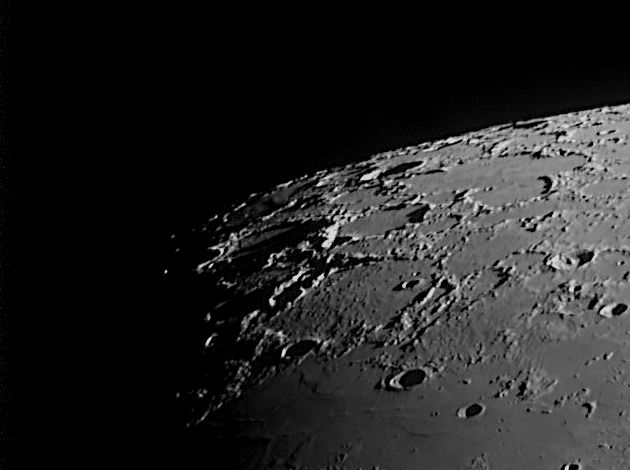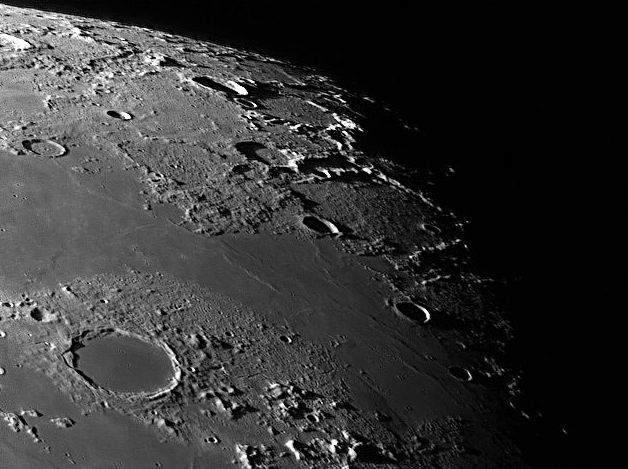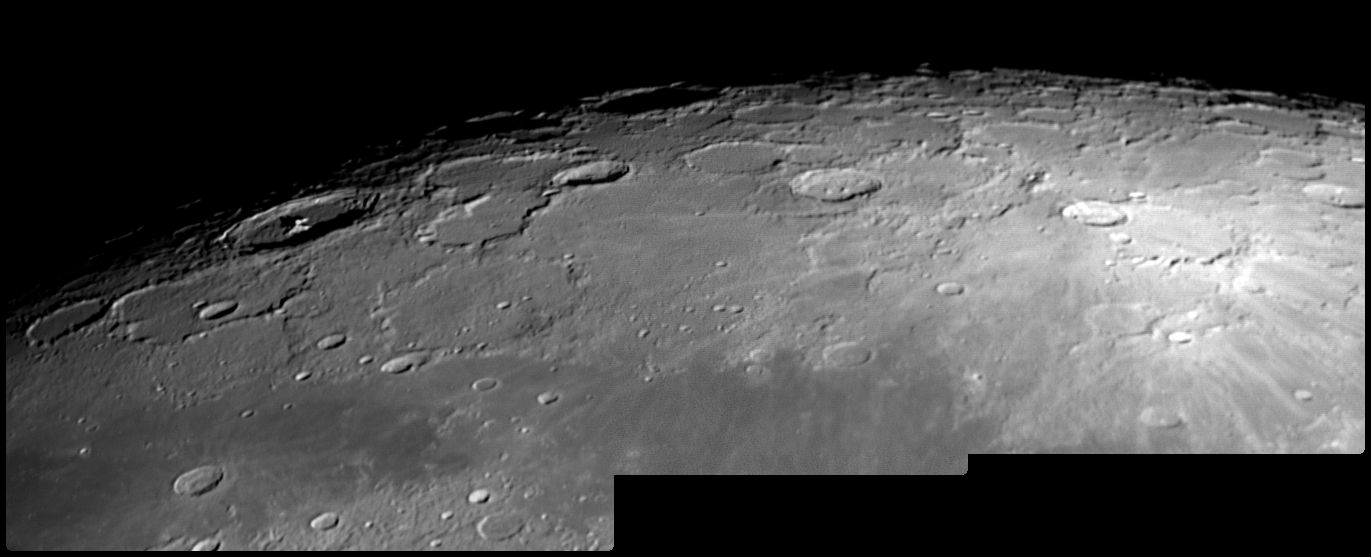Move your mouse over the picture to see the names of the various craters. You
may have to scroll the picture to see the eastern end.
This is a mosaic of three exposures taken of the north polar area. The
libration was favourable at 5° 4' in latitude, 1° 15' in longitude, and the solar inclination was 0.5° which means the north pole is only just illuminated. Currently the libration is particularly good for the northern areas in August but the Moon is also very low in the sky from Britain which makes it more difficult to image. September is a compromise. I have marked the position of the pole as best I can determine it and the arrow points down the prime meridian.
Click on the image to see a larger mosaic of this area taken 20 months later but with very similar libration and lighting. The image and its mouseover total 370K, and the page should open in a new window.
Scale markers are rather pointless in a picture of this area.
Any line pointing to the north pole is north; Anaxagorus, at 73.4° N, is about a degree north of Philolaus and
a degree south of Pascal. Scale also changes considerably both with position and
direction. As a guide, some of the more-prominent craters have the following diameters:
Anaxogorus 53 Km, Philolaus 73 Km, Pascal 103 Km, Pythogorus 133 Km, Carpenter 70 Km, Byrd 97 Km,
Peary 77 Km.
The picture was taken with a ToUcam attached to my LX200 on 16th September 2005 at about 20:45 UT,
when the Moon was 13.4 days old.
| Lunar Phase |
17.1° |
Colongitude |
71.6° |
| Date and Time |
16th September 2005 20:43 to 20:46 UT |
Camera |
ToUcam 740K |
Telescope |
LX200 at prime focus with IR-pass filter |
Capture |
K3CCDTools. Low gamma, 1/33", 18% gain, 4-500 frames |
Processing |
Registax. 62 frames stacked. Wavelet 1-2 = 10, histogram 0-200 |
_____________________________________________________________________________________________________________________________________

|
This picture was taken on day 7.9 and shows the area to the east of the area in the mosaic above. Again taken in infra-red light but this time about an hour before sunset. The bright sky resulted in a flat image which needed considerable enhancement to pull out as much detail as possible.
Once again, one arrow points down the prime meridian, the other indicates approximately 100 Km east.
|
| Lunar Phase |
73.0° |
Colongitude |
15.5° |
| Date and Time |
6th May 2006 18:32 UT |
Camera |
ToUcam 740K |
Telescope |
LX200 at prime focus with IR-pass filter |
Capture |
K3CCDTools. Low gamma, 1/33", 20% gain, 482 frames |
Processing |
Registax. 165 frames stacked. Wavelets 1 = 10, 2 = 5, gamma 2.0, brightness -20 histogram 0-170
Noise reduction in NeatImage.
Brightness -30 in PhotoImpact.
|
_____________________________________________________________________________________________________________________________________

|
This is the area to the south-west of the north pole. It was taken about 37 hours before third quarter, but the solar inclination was -1.3° so the north pole itself was in darkness.
|
| Lunar Phase |
288.9° |
Colongitude |
167.8° |
| Date and Time |
31st August 2010 04:41 UT |
Camera |
DMK 21AF01 |
Telescope |
LX200 at prime focus with IR-pass filter |
Capture |
ICCapture. 1/108", gain 716, 3500 frames |
Processing |
Registax. 107 frames stacked. Wavelets 1 = 10, 2 = 5, gamma 1.2
Focus Magic 1,100.
|
Home Back to NW Quadrant Back to NE Quadrant




